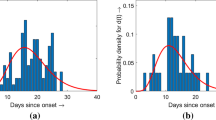Abstract
In the formulation of models for the spread of communicable diseases which include removal and population dynamics, it is necessary to distinguish between removal through recovery with immunity and removal by death due to disease. This distinction must be made because of the difference in the effect on the population dynamics of the different kinds of removal and because there are significant differences in the behavior of the models.
We have formulated a class of models which allow recovery with immunity for a fraction of the infective and permanent removal by death from disease for the remainder. Earlier models of this type have postulated an increased death rate for infective, but such models are restricted to exponentially distributed-infective periods. Because of the differences in behavior between models with recovery and models with permanent removal do not arise when the infective period is exponentially distributed, we have chosen to formulate a different type of model which is sufficiently general to admit qualitative differences.
Similar content being viewed by others
References
Anderson, R. M., & May, R. M. (1979). Population biology of infectious diseases I. Nature, 280, 361–367.
Anderson, R. M., Jackson, H. C., May, R. M., & Smith, A. M. (1981). Population dynamics of fox rabies in Europe. Nature, 289, 765–771.
Bahi-Jaber, N., & Pontier, D. (2003). Modeling transmission of directly transmitted infectious diseases using colored stochastic Petri nets. Mathematical Biosciences, 185, 1–13.
Blythe, S., Nisbet, R. M., & Gurney, W. (1982). Instability and complex dynamic behaviour in population models with long time-delays. Theoretical Population Biology, 22, 147–176.
Brauer, F. (1990a). Models for the spread of universally fatal diseases. Journal of Mathematical Biology, 28, 451–462.
Brauer, F. (1990b). Some infectious disease models with population dynamics and general contact rates. Differential and Integral Equations, 5, 827–836.
Castillo-Chavez, C., Cooke, C., Huang, K. L., & Levin, S. A. (1989). On the role of long incubation periods in the dynamics of acquired immunodeficiency syndrome (AIDS). Part 1: Single population models. Journal of Mathematical Biology, 27, 373–398.
Dietz, K. (1982). Overall population patterns in the transmission cycle of infectious disease agents, in population biology of infectious diseases. In R. M. Anderson & R. M. May (Eds.), Dahlem Konferenz (pp. 87–102). Berlin: Springer.
Heesterbeek, J. A. P., & Metz, J. A. J. (1992). The saturating contact rate in marriage and epidemic models. Centrum voor Wiskunde en Informatica, Amsterdam, the Netherlands.
Hethcote, H. W. (1974). Asymptotic behavior and stability in epidemic models. In Lecture notes in biomathematics (Vol. 2, pp. 83–92). Berlin: Springer.
Hethcote, H. W., Stech, H. W., & van den Driessche, P. (1981). Stability analysis for models of diseases without immunity. Journal of Mathematical Biology, 13, 185–198.
Kermack, W. O., & McKendrick, A. G. (1927). A contribution to the mathematical theory of epidemics. Proceedings of the Royal Society of London, Series A, 115, 700–721.
Li, X., & Xu, L. (1991). An integrated information system for the intervention and prevention of AIDS. International Journal of Bio-Medical Computing, 29, 191–206.
Miller, R. K. (1971). Asymptotic stability properties of linear Volterra integro-differential equations. Journal of Differential Equations, 10, 485–506.
Pugliese, A. (1990). Population models for diseases with no recovery. Journal of Mathematical Biology, 28, 65–82.
Rubin, W. (1987). Real and complex analysis (3rd ed.). New York: McGraw-Hill.
Thieme, H. R., & Castillo-Chavez, C. (1989). On the role of variable infectivity in the dynamics of the human immunodeficiency virus. In C. Castillo-Chavez (Ed.), Lecture notes in biomathematics : Vol. 83. Mathematical and statistical approaches to AIDS epidemiology (pp. 157–177). Berlin: Springer.
Van den Driessche, P., & Zou, X. (2007). Modeling relapse in infectious diseases. Mathematical Biosciences, 207, 89–103.
Author information
Authors and Affiliations
Corresponding author
Rights and permissions
About this article
Cite this article
Huang, G., Li, L. A mathematical model of infectious diseases. Ann Oper Res 168, 41–80 (2009). https://doi.org/10.1007/s10479-008-0373-7
Published:
Issue Date:
DOI: https://doi.org/10.1007/s10479-008-0373-7




